Outsourcing to Czechia

How much does it cost to hire developers in Czechia?
Dec 2nd 25 - by Devico Team
Find out how much it costs to hire software developers in Czechia in 2025. Compare hourly rates, roles, and factors that impact pricing.
Hire
Hire by role
Hire Front-end developers
Hire Back-end developers
Hire Full-stack developers
Hire Android developers
Hire iOS developers
Hire Mobile developers
Hire AI engineers
Hire ML engineers
Hire Automation QA engineers
Hire Blockchain developers
Hire Data engineers
Hire Cloud engineers
Hire by skill
Hire JavaScript developers
Hire TypeScript developers
Hire Ruby on Rails developers
Hire React Native developers
Hire Flutter developers
Hire Golang developers
Hire React.js developers
Hire Python developers
Hire PHP developers
Hire .NET developers
Hire Java developers
Hire Laravel developers

Data engineering
July 12, 2024 - by Devico Team
Summarize with:
We all face an unprecedented pace of data generation. The World Economic Forum stated that by 2025, people will generate 463 exabytes of data daily. Imagine 212 DVDs per day — that’s exactly the amount. On the one hand, it’s pretty scary — chances are we’ll impair people’s FOMO (fear of missing out). On the other hand, this staggering volume represents a vast reservoir of potential insights and opportunities for businesses across all sectors.
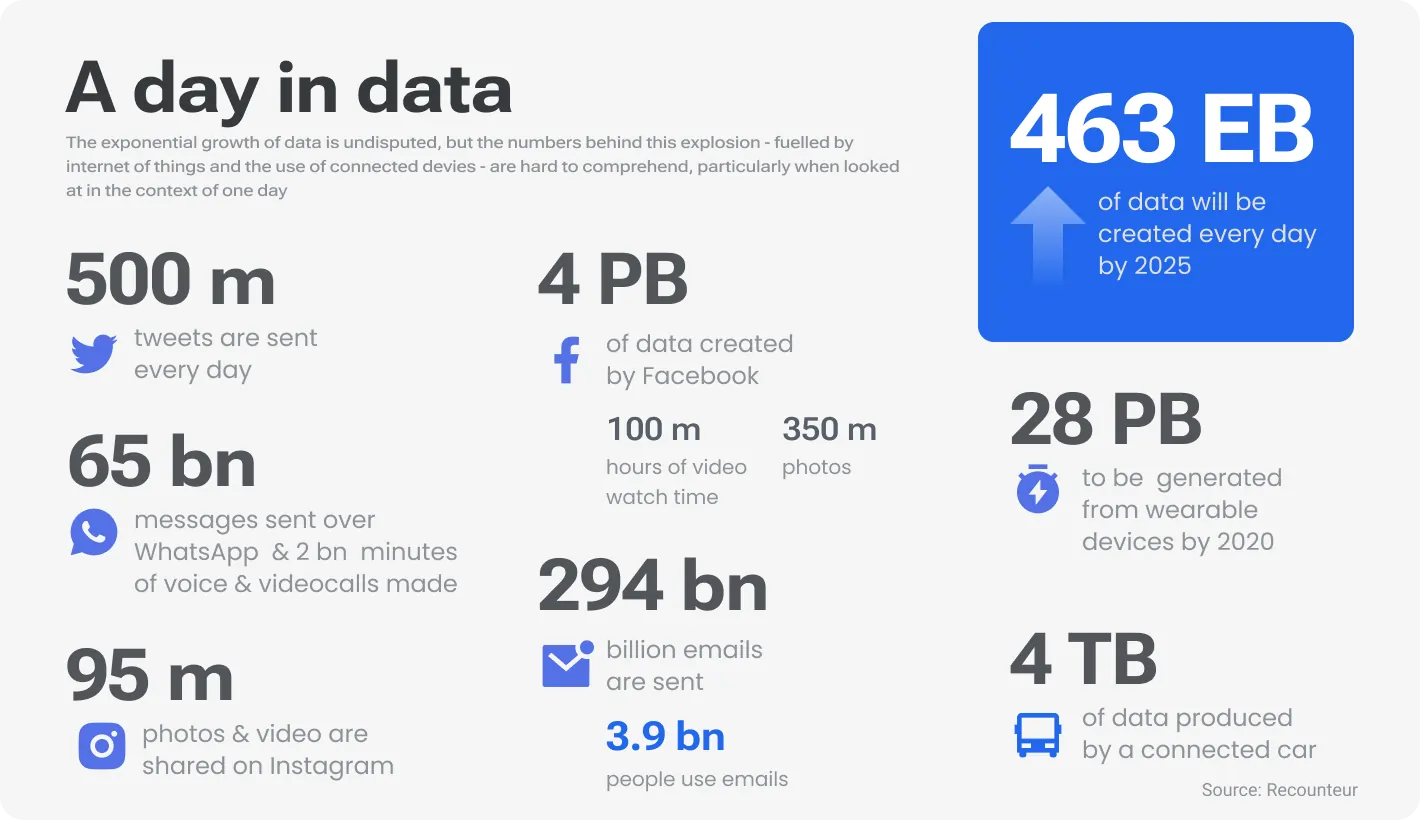
While big data is a valuable asset, it is not inherently useful in its raw form. To leverage its potential, organizations must develop effective strategies that can transform this vast array of information into actionable insights. Without a solid plan to make sense of all that information, it’s like having a library of books in a language you don't understand. You know there's valuable knowledge there, but you can't access it.
At the same time, big data can be a game-changer for any company. It allows businesses to analyze vast amounts of structured, semi-structured, and unstructured data, uncovering hidden patterns, trends, and customer behaviors. All that scope of information is just impossible to detect with traditional methods — big data development provides the tools and techniques to sift efficiently and drive value.
While we're on the subject of significance, the concept of "business value" in big data projects is multifaceted, encompassing improvements in efficiency, revenue growth, and enhanced customer experiences.
Most obvious example: by analyzing large sets of customer interaction data, a retailer can identify buying patterns and preferences, which can then be used to tailor marketing strategies. This, in turn, is leading to increased sales and customer satisfaction. This is how the value of data magically turns into business value.
As you already understood, big data on its own isn't enough. To truly unlock its potential and generate a return on investment, businesses need a well-defined big data development strategy.
This one goes beyond just the technology; it's about aligning big data initiatives with clear business objectives. Like a powerful engine, but without a map or destination, you might end up nowhere. A big data strategy is your roadmap; ensures your data exploration drives you towards achieving specific business goals.
Nowadays, many can say that big data software development turned into just a buzzword. However, big data is a powerhouse instrument that can dramatically enhance a company's operations across multiple dimensions. Here's how big data development can unlock tangible benefits across various domains.
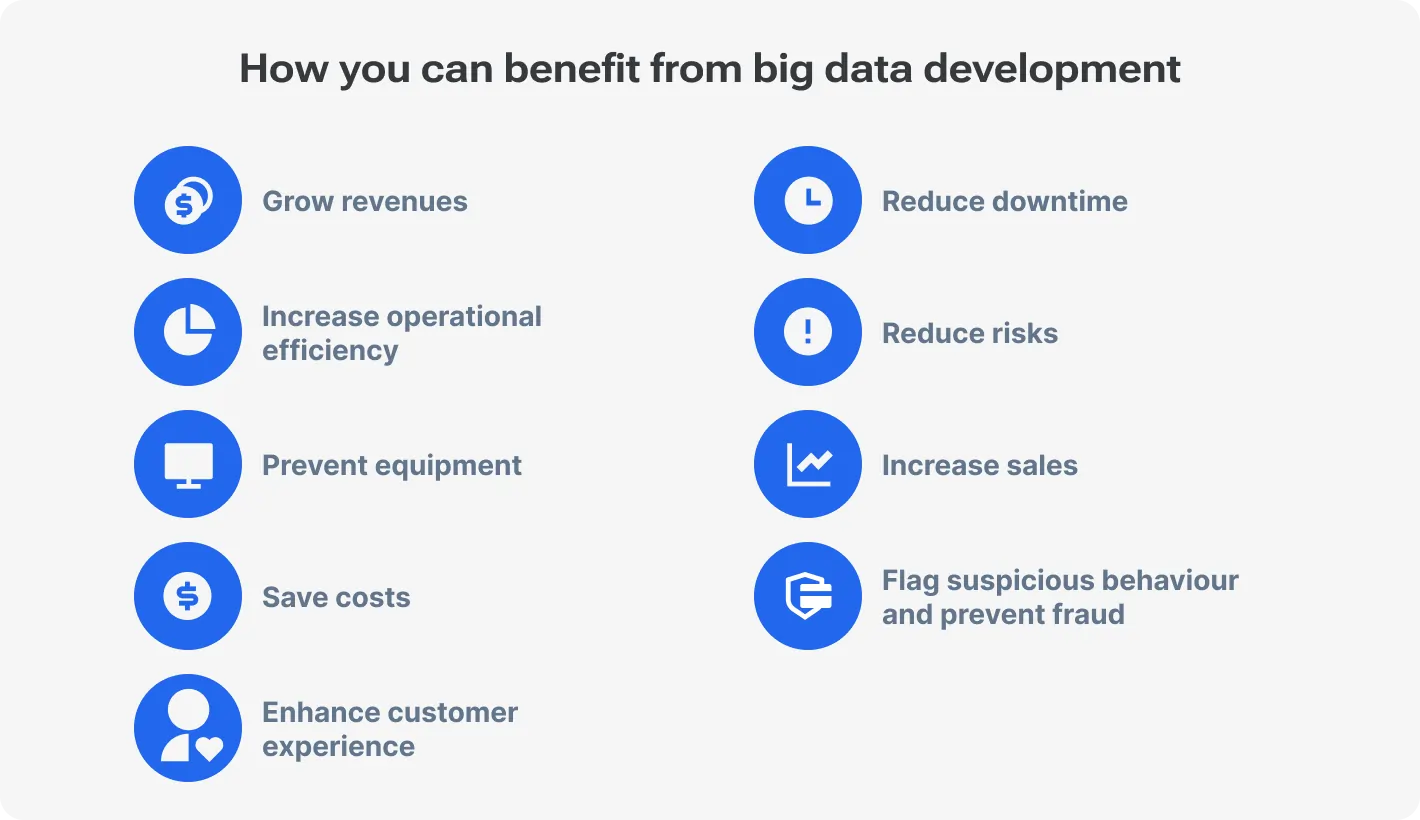
Let’s face it, you’d like to know your customers better. Literally, you want to know all about them since this knowledge empowers you to create tailored products or services and promote them accordingly. Chances are we are right.
To this end, big data is a very powerful aid. Although it doesn’t allow to know the customer inside out, it still allows businesses to dive deep into vast datasets to extract meaningful insights about their customers, operations, and market trends.
For instance, a retailer analyzing customer purchase patterns and seasonal trends can optimize their stock levels and this way, reduce overhead costs and maximize sales opportunities. This type of data-driven decision-making leads to smarter, more effective business strategies.
Sincere attention and care are king. In the previous passage, we mentioned customized promotional campaigns in passing. So, tailored offers are one of the care types because you don’t waste clients’ time on endless proposals they simply don’t need. In addition, companies with a data-driven approach can create highly personalized marketing campaigns that resonate with individual customer preferences and behaviors.
For example, an e-commerce site might use browsing and purchase history to suggest products that a customer is likely to buy. Moreover, predictive analytics can help businesses anticipate customer needs and address potential issues before they become problems, ensuring a smoother customer journey.
Big data enables organizations to streamline their operations by identifying inefficiencies and bottlenecks. The most interesting trick here is exploiting real-time data processing. The business world has become increasingly data-centric and customer-centric, so the mentioned solutions are extremely beneficial, as they save time. By doing and processing the vast amount of data in real-time, you can deliver immediate value to customers.
Through leveraging big data for development, a manufacturing company could discover that a particular machine frequently breaks down, or that the program the machine runs on contains a critical bug. With such information under their belt, they can address this issue and improve uptime and productivity, directly impacting the bottom line.
With big data, companies can better predict and mitigate risks by analyzing patterns that precede undesirable events. Financial institutions, for instance, use big data to model various economic scenarios and stress test their portfolios against potential crises, thereby safeguarding against future losses.
An unconventional application of big data drives another value — environmental sustainability. Companies can use data analytics to monitor and reduce their carbon footprint (at least).
Imagine a logistics company analyzing route data and vehicle performance to optimize delivery routes. Potentially, they can save fuel alongside reducing greenhouse gas emissions. This approach not only helps the planet but can also improve the company’s image and compliance with increasing environmental regulations.
Another instance. Big data analytics has allowed researchers to track outbreaks of diseases and even predict the spread of epidemics. This can be used to respond to public health threats more rapidly and effectively. Big data can also help pinpoint which regions have high crime volumes, ensuring that police departments are better equipped to allocate their resources judiciously; individuals, in turn, can assist in producing safer neighborhoods.
Big data application development goes beyond collecting and analyzing vast amounts of data. Basically, its core is ensuring that analytics efforts align perfectly with your business goals. Your starting point should definitely be a clear set of objectives, as it directs the focus of your big data initiatives and ensures they deliver tangible value.
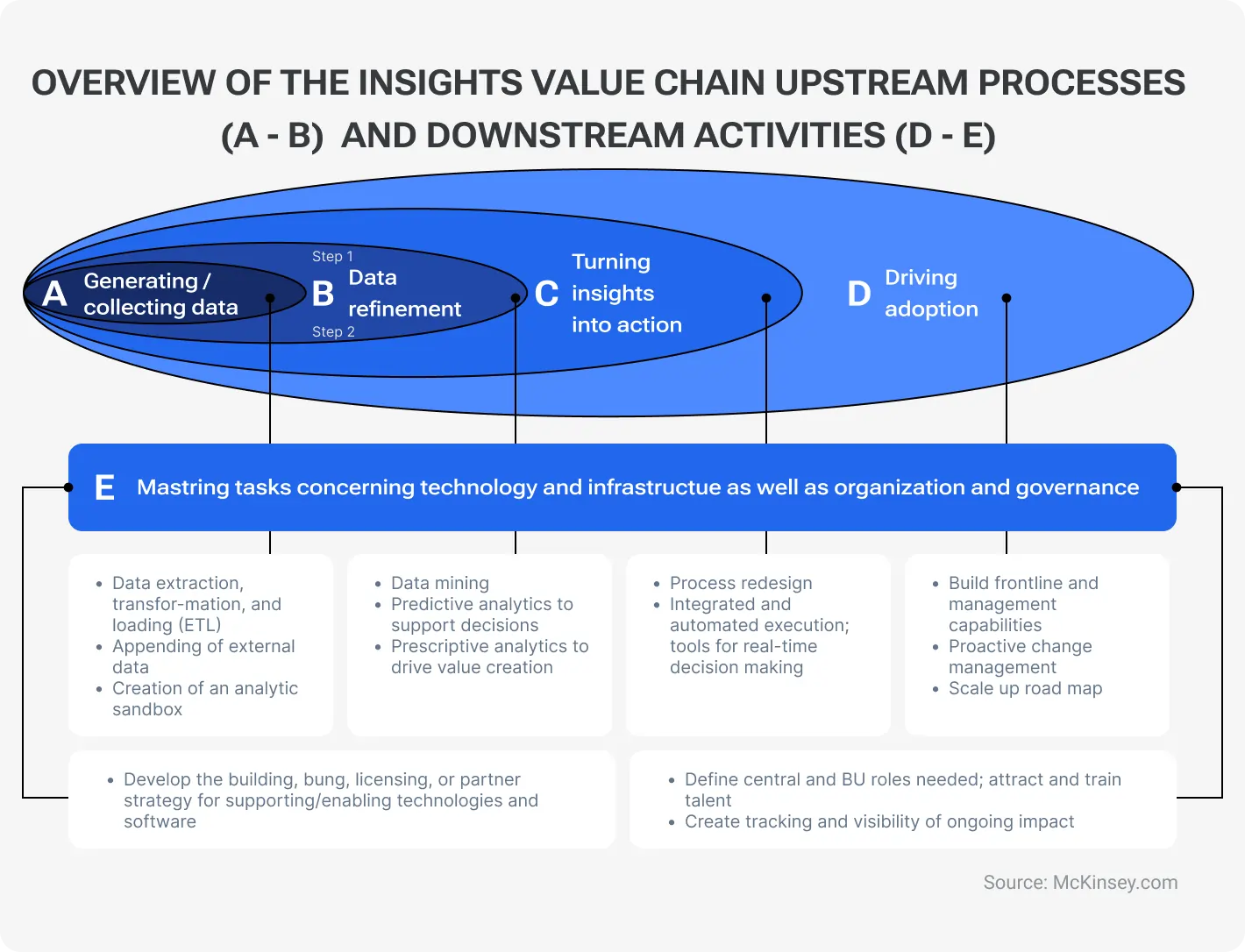
1/ Define the key business goals: As previously mentioned, it is critical to start by creating an understanding of what an organization plans to achieve with big data. Are the business leaders interested in improving customer satisfaction, optimizing operational efficiency, or increasing the competitive advantage? Identification of major challenge areas or opportunities to be addressed using big data is necessary to drive a strategy and investment.
2/ Assess the current data state: A company’s current data landscape should also not be underestimated. Tools such as Talend and Informatica, which offer end-to-end data integration and quality capabilities, allow the detection of existing data sources, their quality, and availability.
Data sources: Identify all the sources of data within your company, both internal (e.g., CRM systems, sales data) and external (e.g., social media data, customer surveys). Pencil in using Alteryx Designer or open-source frameworks like Apache Atlas; they can be helpful in data discovery and lineage processes.
Data quality: Not all data is equal and relevant. Is the particular piece accurate, complete, and consistent? We can’t help but admit that “dirty” data leads to irrelevant insights. Use OpenRefine or Trifacta Wrangler for data cleansing.
Data accessibility: How easily can your data be accessed and analyzed? Are there data silos hindering collaboration? Invest in data governance strategies and tools to ensure your data is accessible to those who need it.
The platforms mentioned can also perform data profiling and quality assessments, giving you a clear view of your data's health and readiness for big data projects.
3/ Choose an appropriate data set: Once you have set business goals, it’s time to select data sets that directly relate to them since focusing on the analysis will yield valuable insights. Let’s say, your objective is to improve customer service, so you should prioritize data from customer interactions and feedback channels.
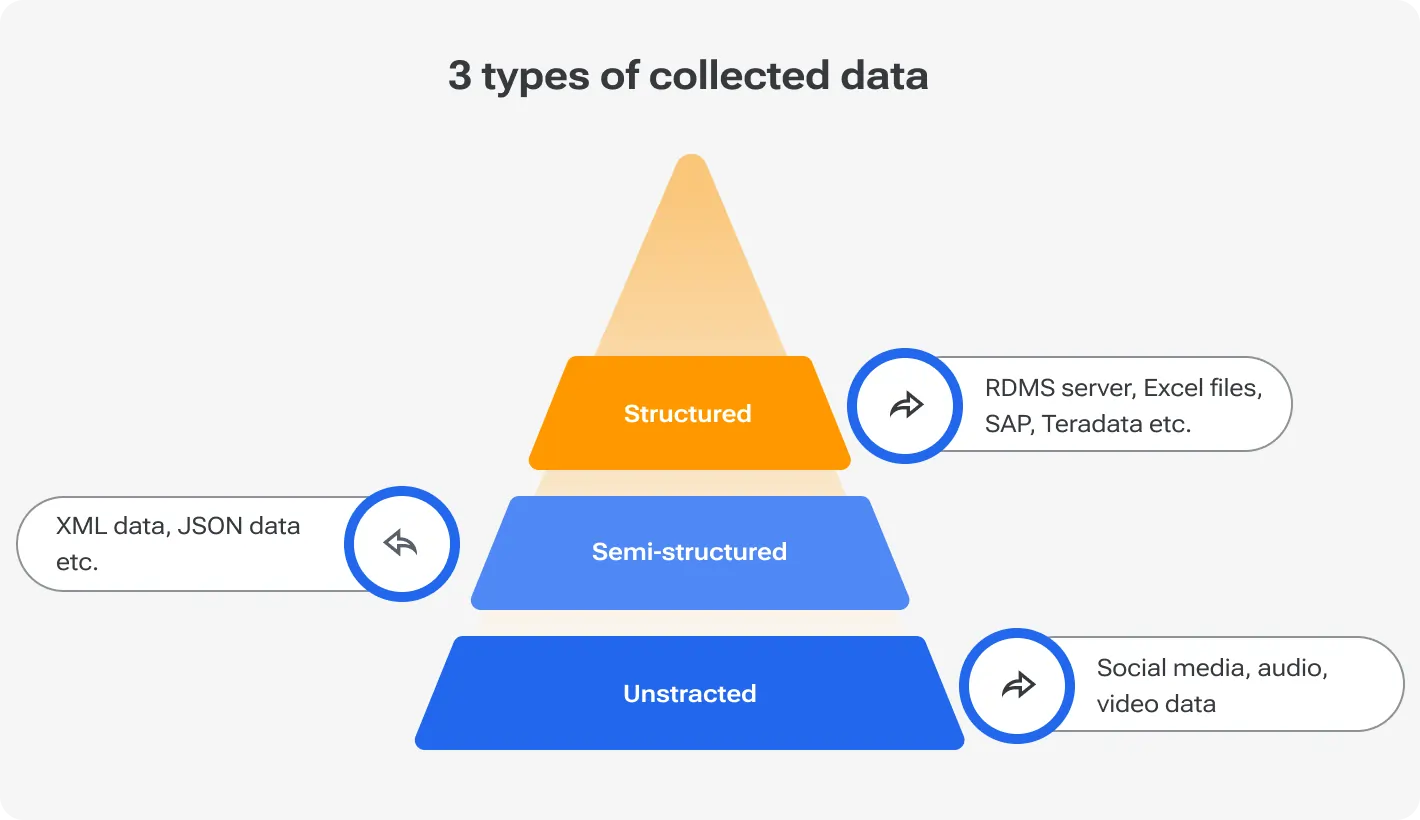
4/ Develop a big data roadmap: The rule of thumb is to break down the big objective into small measurable actions. Map the necessary steps, resources, and technologies required to implement your big data strategy. Make sure to include timelines, milestones, and the specific data technologies and tools that you will use. Each phase of the roadmap must contribute directly to achieving the identified business goals.
5/ Measure success and ROIi: Clear KPIs are the best instruments that will show the effectiveness of your big data projects. Try to track at least the main ones:
Customer retention: One of the most valuable metrics if you’re looking for insights. Shows one of two most important qualities of your product/service — why do they buy from you. Calculate the simple option of the Retention Rate this way:

Operational efficiency: Improvement can be measured by reduced costs or increased throughput, with metrics such as cost per transaction or units produced per hour.

Sales growth: First step is to measure sales volume before the big data project. The second is the same move just after. That’s simple.
If you follow these steps and consistently measure outcomes against KPIs, chances are you will ensure the big data initiatives are aligned with your strategic goals, show the real value of data, and drive meaningful business outcomes.
Big data technology is not the whole puzzle, it’s just one piece. To truly maximize the value you extract from it, there are several crucial aspects to consider beyond the technical infrastructure. Let’s ride through five key considerations in that matter.
Crucial aspect for ensuring the integrity and usability of big data. Establish clear policies and procedures for data quality, security, and ownership. This one is probably the most obvious yet effective advice we can give. This helps maintain standards along with accountability. The framework should include guidelines on data access, usage, and archiving, ensuring that data remains accurate, consistent, and secure throughout its lifecycle.
Building a competent team is vital for big data success. Keep an eye on specialists with domain knowledge in data science and big data technologies alongside domain-specific knowledge that can help tailor big data insights to business contexts.
Data analysts can decode raw data into meaningful insights, while data engineers design and develop the infrastructure to store, manage, and analyze this data. Additionally, if you have team members with deep industry knowledge, chances are your company as a single organism will understand the context behind the data.
Don’t forget about training and development — this helps to keep the team updated with the latest data techniques and tools.
Don’t want to sound pathetic, nonetheless, robust data security measures are really non-negotiable due to the sensitive nature of many data sets. Any company must implement comprehensive security strategies like:
encryption,
regular security audits,
access controls.
These help protect data from unauthorized access and breaches. Additionally, compliance with data privacy regulations like GDPR or HIPAA is also mandatory to avoid legal repercussions. Recall the 2017 Equifax breach: insufficient data security measures exposed the sensitive information of approximately 147M people. Cautionary enough to implement stringent security practices and be aware of the severe consequences of their absence.
We can include nurturing a data-driven culture in the list of crucial aspects. Encouraging a corporate mindset that values data-driven decision-making can become a game-changer in the effectiveness of big data initiatives. And one more time, train your staff across all levels to think analytically and make decisions based on data insights rather than intuition alone. Intuition is also helpful, however, not everyone has it really fine-tuned.
Smooth operations within your company will hang by a thread without proper integration of big data solutions with existing IT systems and business processes. Yet, while it’s strategic and carefully planned, big data tools will complement and enhance existing processes without causing disruptions. Effective collaboration between IT and business units will facilitate this integration, and this is their responsibility to translate big data insights into actionable business strategies.
Learn top strategies for improving your data engineering workflows
Big data is a pretty practical powerhouse that companies across various industries are using to drive significant business outcomes. Here are three real-world examples of famous companies that have successfully employed the power of big data to solve challenges and boost their operations.
Amazon needs no introduction. And it would be strange for a cutting-edge retailer not to use big data. And it uses — Amazon’s data development initiatives create highly personalized shopping experiences for millions of customers.
We cannot list exactly which data Amazon analyzes since there is a sea of nuances apart from privacy policies. However, what we can state is that they analyze vast amounts of data from browsing history, purchase patterns, and customer ratings.
After processing (which is lightning fast) Amazon offers tailored product recommendations. Its one-exabyte collection of purchase history data has helped them beef up customer satisfaction and significantly increase sales — experts predict that by the end of 2024, Amazon will hit 50% of the market share. And the company’s recommendation engine plays a crucial role in an estimated 35% of its total sales.
Starbucks uses big data analytics to determine the potential success of new store locations and to customize menu options. It also optimizes the menu: adding new drink flavors, desserts, etc.
Basically, they analyze demographic data, customer traffic patterns, and area-specific buying preferences. This way, Starbucks pinpoints optimal locations for new stores and offers localized menu items that resonate with regional tastes. This strategic move has enabled Starbucks to enhance its market penetration — as of 2022, their reward program had over 13M active users.
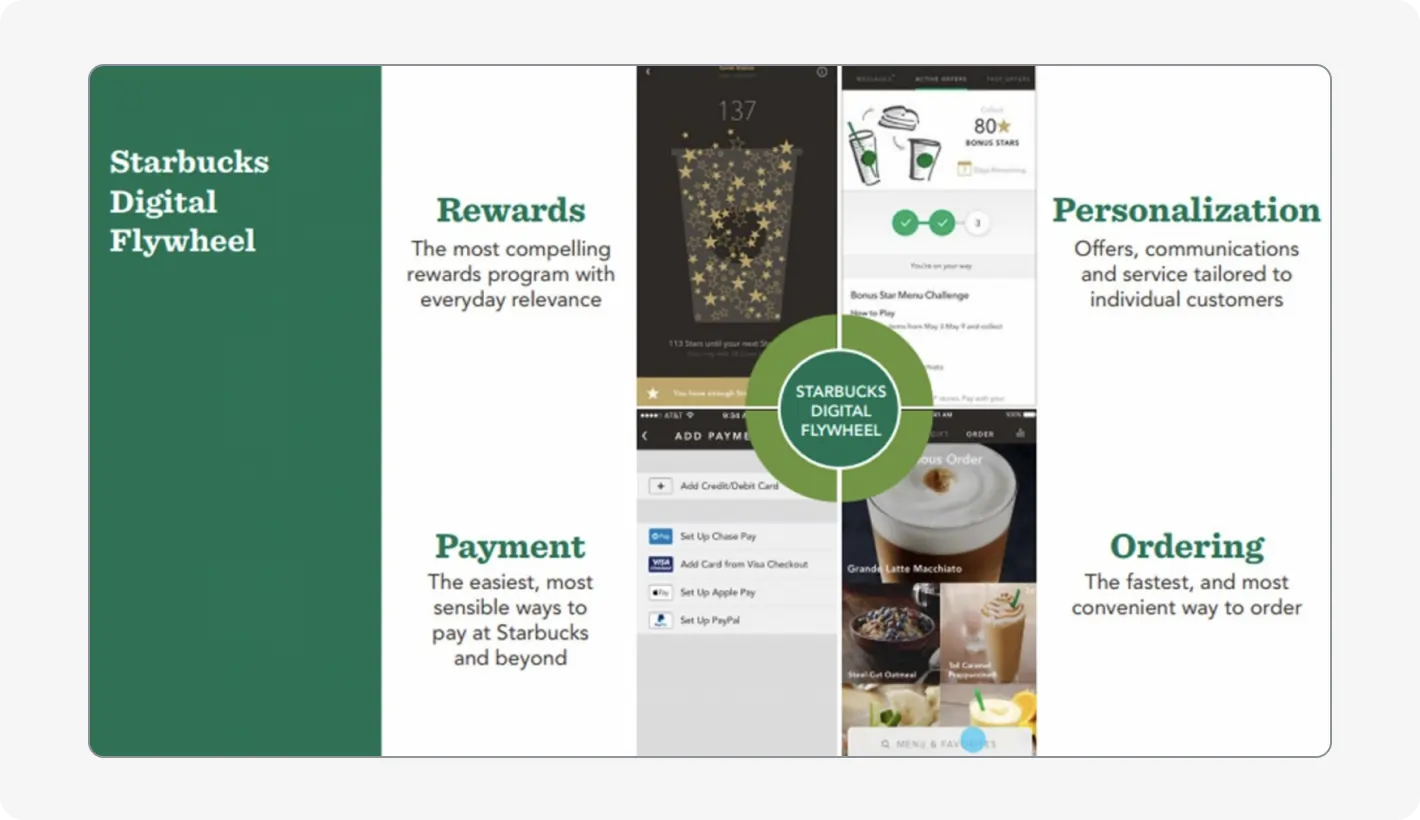
Last but not least. Netflix's use of big data to guide content creation and recommendations is a prime example of data-driven decision-making.
Every time you watch something on Netflix, your data, including watch times, pause and rewind frequency, and – obviously! – preferred genres, allow entertainment giants to tailor its recommendations and to inform its original content production.
This strategy helped them increase viewer engagement and retention, saving USD 1 billion a year in value. Netflix clearly understands that many people become jaded, so the company is always on the lookout for new formats. For this reason, the leading entertainment platform offered a USD 1M prize to anyone who came up with the best predictive algorithm.
Big data holds immense potential, but a strategic approach is crucial to unlocking the true value of data. Navigating the world of big data development could be challenging when you are just about to hit this journey. Just remember, big data is not a silver bullet.
Although it's a powerful tool, it can’t replace your own experience as a CEO, data specialist, or marketer. In addition, it requires clear direction. Aligning your big data strategy with specific business objectives ensures your data exploration drives real impact.
Zero in on understanding your current data landscape, select the data most relevant to your goals and develop a plan with measurable outcomes. To this end, your most valuable asset is a data-savvy team. So, invest in your people, foster a data-driven culture within your company, and encourage experiments.
If you need a helping hand or a launching spurt, Devico's team of big data experts can help you develop a customized strategy tailored to your unique needs. Schedule a free one-hour consultation today to explore how we can empower you with big data.
Outsourcing to Czechia

Dec 2nd 25 - by Devico Team
Find out how much it costs to hire software developers in Czechia in 2025. Compare hourly rates, roles, and factors that impact pricing.
Outsourcing to Czechia

Nov 25th 25 - by Devico Team
Compare Czechia and Poland for software outsourcing in 2025. Discover costs, talent, infrastructure, and which country fits your project best.
Outsourcing to Czechia

Nov 18th 25 - by Devico Team
A complete guide to outsourcing software projects to Czechia, learn about costs, talent, benefits, and how to build successful partnerships in 2025.